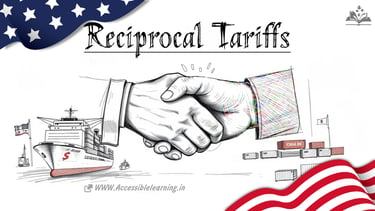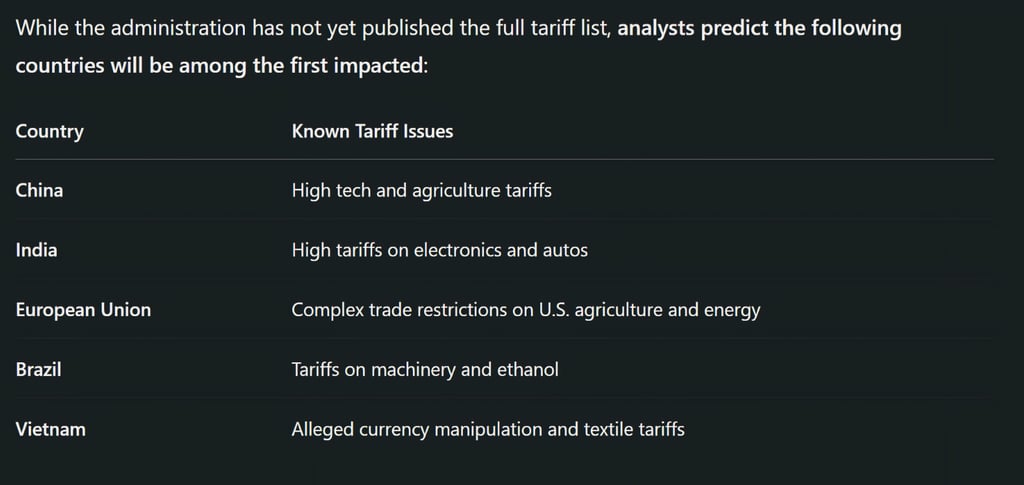
Reciprocal Tariffs Announced by US President: A New Era of Fair Trade
The US President announces reciprocal tariffs to balance global trade. Learn what it means for businesses, consumers, and the future of international commerce.
NEWS/CURRENT AFFAIRSUSAPOLITICAL JOURNEY
Kim Shin
4/6/20255 min read


In a move that has already begun to send ripples through global markets, the President of the United States has officially announced the rollout of reciprocal tariffs. This policy aims to establish fairness in global trade by mirroring the trade barriers imposed on American goods by other countries.
Supporters hail the decision as long overdue. Critics, however, warn of economic retaliation and rising costs. As the world watches closely, here’s everything you need to know—broken down clearly and humanely.
Understanding Reciprocal Tariffs in Plain Terms
In basic terms, reciprocal tariffs are “you-tariff-me, I-tariff-you” measures. If a foreign country imposes a 25% duty on U.S. machinery, under this policy, the U.S. will respond with the same 25% tariff on that country’s comparable exports.
The goal? To create leverage—to either force a reduction in foreign tariffs or raise barriers for those unwilling to engage fairly.
It’s not just about dollars and cents; it’s also about economic dignity and ensuring that U.S. businesses aren't being used as a “cheap mall” for nations that don’t return the favor.
Why the U.S. President Chose This Path
The announcement comes amid growing frustration over chronic trade imbalances, particularly with countries that heavily tax American products while enjoying low-duty or duty-free access to U.S. markets.
Key reasons for the move include:
Reviving Domestic Manufacturing
The White House believes that reciprocal tariffs will discourage offshoring and reignite domestic industries that have been battered by cheap imports.
Strengthening Bargaining Power
The administration views this as a negotiation tactic. Many bilateral trade discussions are expected to open with the message, “Drop your tariffs—or face ours.”
Election-Year Economics
With elections looming, this move is also aimed at energizing the working-class voter base, particularly in manufacturing-heavy swing states like Michigan, Ohio, and Pennsylvania.

Expanded Impact: Who Gains, Who Loses?
Winners
Steel and Aluminum Industries
These sectors have been struggling with dumping practices from countries like China. A mirrored tariff could ease competition and stabilize pricing.
Small-to-Midsize Manufacturers
Domestic producers could finally compete on a level playing field without being outpriced.
Labor Unions and Skilled Workers
A renewed focus on American-made goods could result in job creation and wage increases in key sectors.
Losers
Retail and Import-Heavy Businesses
Companies dependent on imported goods, such as electronics and apparel retailers, may face higher costs and thinner margins.
Consumers
Many household products could become more expensive, particularly if alternative U.S.-made versions are not readily available or cost more.
Farmers and Agricultural Exporters
U.S. farmers are often the first to be hit with retaliatory tariffs. In past trade disputes, countries like China have targeted soybeans, pork, and corn—a trend that could repeat.
Strategic Targets: Which Countries Could Be Affected First?


Global Implications: Are We Headed Toward a Trade War?
The global reaction has been a mix of caution, criticism, and counter-preparation. Here’s what’s unfolding:
The EU is reportedly drafting a retaliatory list should their automotive exports be hit.
China is monitoring developments closely while emphasizing the need for cooperation.
Developing nations fear a domino effect, where tariff retaliation disrupts global supply chains.
Many trade economists fear that this move could trigger a chain reaction of protectionism, undermining decades of free-trade progress fostered through organizations like the WTO (World Trade Organization).
Market Response: Stocks, Supply Chains, and Sentiment
Financial markets are reacting cautiously. As of now:
Stock indexes showed short-term volatility, especially in sectors like retail, agriculture, and tech.
Supply chain experts are warning of delays and rerouting as companies rework logistics strategies.
Currency markets may be affected as trade shifts impact national export revenues.
Expert Takeaways and Balanced Viewpoints
Notable economists and trade scholars are offering divided—but insightful—opinions.
Dr. Robert Altman, Trade Policy Fellow at Brookings:
“Reciprocal tariffs might make sense politically, but economically they risk a tit-for-tat spiral that rarely ends well for anyone.”
Jennifer Lee, Economist at BMO Capital:
“It’s not just about tariffs—it’s about leverage. If used tactically, this could usher in more balanced trade deals.”
Key Measures to Watch
The government has outlined follow-up steps to monitor and adapt the policy:
Biannual review of global tariff structures.
Public comment periods to assess impact on industries and consumers.
Creation of a Trade Reciprocity Task Force to oversee implementation.
What Can Businesses and Consumers Do?
For Businesses
Reassess global supply chains and diversify sourcing.
Prepare for possible cost fluctuations.
Consider investing in domestic production partnerships.
For Consumers
Watch for pricing changes, especially in electronics, clothing, and imported foods.
Support local and American-made brands to offset reliance on foreign goods.
FAQs
What are reciprocal tariffs?
Reciprocal tariffs are trade measures where a country imposes the same tariffs on another country’s goods that the other country imposes on theirs. If Country A taxes U.S. products at 20%, the U.S. responds with a matching 20% tariff on imports from Country A.
Why did the US President announce reciprocal tariffs?
The President introduced reciprocal tariffs to promote fair and balanced trade, reduce trade deficits, and protect U.S. industries from countries that impose high duties on American goods while benefiting from easy access to U.S. markets.
Which countries are most likely to be affected?
Countries with high tariffs on U.S. exports, such as China, India, the European Union, Brazil, and Vietnam, are expected to be among the first affected by this policy shift.
How will reciprocal tariffs impact American consumers?
Consumers may experience higher prices on imported goods, especially in sectors like electronics, clothing, and household products. However, the policy aims to boost domestic production and job growth in the long run.
Will this lead to a global trade war?
While the risk of retaliatory tariffs exists, the U.S. government states that the goal is negotiation, not confrontation. However, global reactions vary, and some trade tensions may escalate depending on how countries respond.
How will this affect American businesses and industries?
U.S. manufacturers and industries like steel, aluminum, and machinery may benefit from reduced foreign competition. On the other hand, import-reliant businesses may face increased costs and disrupted supply chains.
What can businesses do to prepare for reciprocal tariffs?
Businesses should assess their import/export dependencies, explore alternative suppliers, consider reshoring operations, and stay updated on evolving trade regulations and tariff lists.
Are reciprocal tariffs permanent?
Not necessarily. The policy will be subject to periodic review, diplomatic negotiations, and industry feedback. If foreign countries adjust their tariffs, the U.S. may modify or lift corresponding reciprocal measures.
The U.S. President’s announcement of reciprocal tariffs is more than a headline—it’s a statement about how America intends to engage in global trade going forward. This policy could redefine relationships with economic giants and trading partners alike.
Whether this becomes a catalyst for fairer trade or a trigger for trade wars will depend on diplomacy, timing, and the global community’s willingness to adapt. For now, businesses must stay agile, consumers must stay informed, and policymakers must tread carefully.
Subscribe to our newsletter
All © Copyright reserved by Accessible-Learning
| Terms & Conditions
Knowledge is power. Learn with Us. 📚


